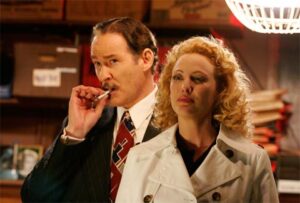HEADLINE: BURY HIM NOT
A Prairie Home Companion
Color, PG-13 (strong language), 106 mins plus supplements, Dolby Digital 5.1, letterboxed; $27.95, Street: October 10; NEW LINE
 At 81, Robert Altman is apparently getting just a little tired of doing DVD commentary tracks. The legendary director, who received an honorary career Oscar earlier this year, starts to get weary as he watches this, his touching but steadfastly anti-sentimental rendition of the NPR show created by Garrison Keillor. Altman yawns and apologizes, nothing how much he enjoys the picture, but wonders at one point if the listeners are growing tired of hearing himself and co-commentator Kevin Kline. For his part, Kline is an engaging “interviewer” — he even discusses the contagiousness of yawning with Altman — and in the earliest part of the commentary strikes gold when the asks Altman about the overwhelming presence of mirrors in an important lengthy scene between Meryl Streep, Lily Tomlin and Lindsay Lohan. Altman provides a few straight answers to Kline’s questions, but for the most part prefers to joke about how little he does as a director. He seems far more honest about his organizational abilities in the behind-the-scenes featurette that appears here. Scripter-star Keillor, who inexplicably isn’t on the commentary track, gets the lion’s share of attention in the documentary, as he reviews the history of his radio show, discusses the genesis of the film project and is verbally saluted by cast members Streep, Tommy Lee Jones and Virginia Madsen, who all claim to be devoted listeners. Missing from both the documentary and the audio commentary are three rather important topics: the models for the film (Altman’s previous music pics, from Nashville to The Company), any mention of the film’s subject matter (which Altman clearly outlined in interviews as, simply put, death) and any appearance by a very key player, cinematographer Ed Lachman. The disc’s third bonus, a selection of complete instrumental musical numbers, only serves to spotlight how extremely important his elegantly smooth camerawork is to this wonderfully elegiac film. —Ed Grant
At 81, Robert Altman is apparently getting just a little tired of doing DVD commentary tracks. The legendary director, who received an honorary career Oscar earlier this year, starts to get weary as he watches this, his touching but steadfastly anti-sentimental rendition of the NPR show created by Garrison Keillor. Altman yawns and apologizes, nothing how much he enjoys the picture, but wonders at one point if the listeners are growing tired of hearing himself and co-commentator Kevin Kline. For his part, Kline is an engaging “interviewer” — he even discusses the contagiousness of yawning with Altman — and in the earliest part of the commentary strikes gold when the asks Altman about the overwhelming presence of mirrors in an important lengthy scene between Meryl Streep, Lily Tomlin and Lindsay Lohan. Altman provides a few straight answers to Kline’s questions, but for the most part prefers to joke about how little he does as a director. He seems far more honest about his organizational abilities in the behind-the-scenes featurette that appears here. Scripter-star Keillor, who inexplicably isn’t on the commentary track, gets the lion’s share of attention in the documentary, as he reviews the history of his radio show, discusses the genesis of the film project and is verbally saluted by cast members Streep, Tommy Lee Jones and Virginia Madsen, who all claim to be devoted listeners. Missing from both the documentary and the audio commentary are three rather important topics: the models for the film (Altman’s previous music pics, from Nashville to The Company), any mention of the film’s subject matter (which Altman clearly outlined in interviews as, simply put, death) and any appearance by a very key player, cinematographer Ed Lachman. The disc’s third bonus, a selection of complete instrumental musical numbers, only serves to spotlight how extremely important his elegantly smooth camerawork is to this wonderfully elegiac film. —Ed Grant